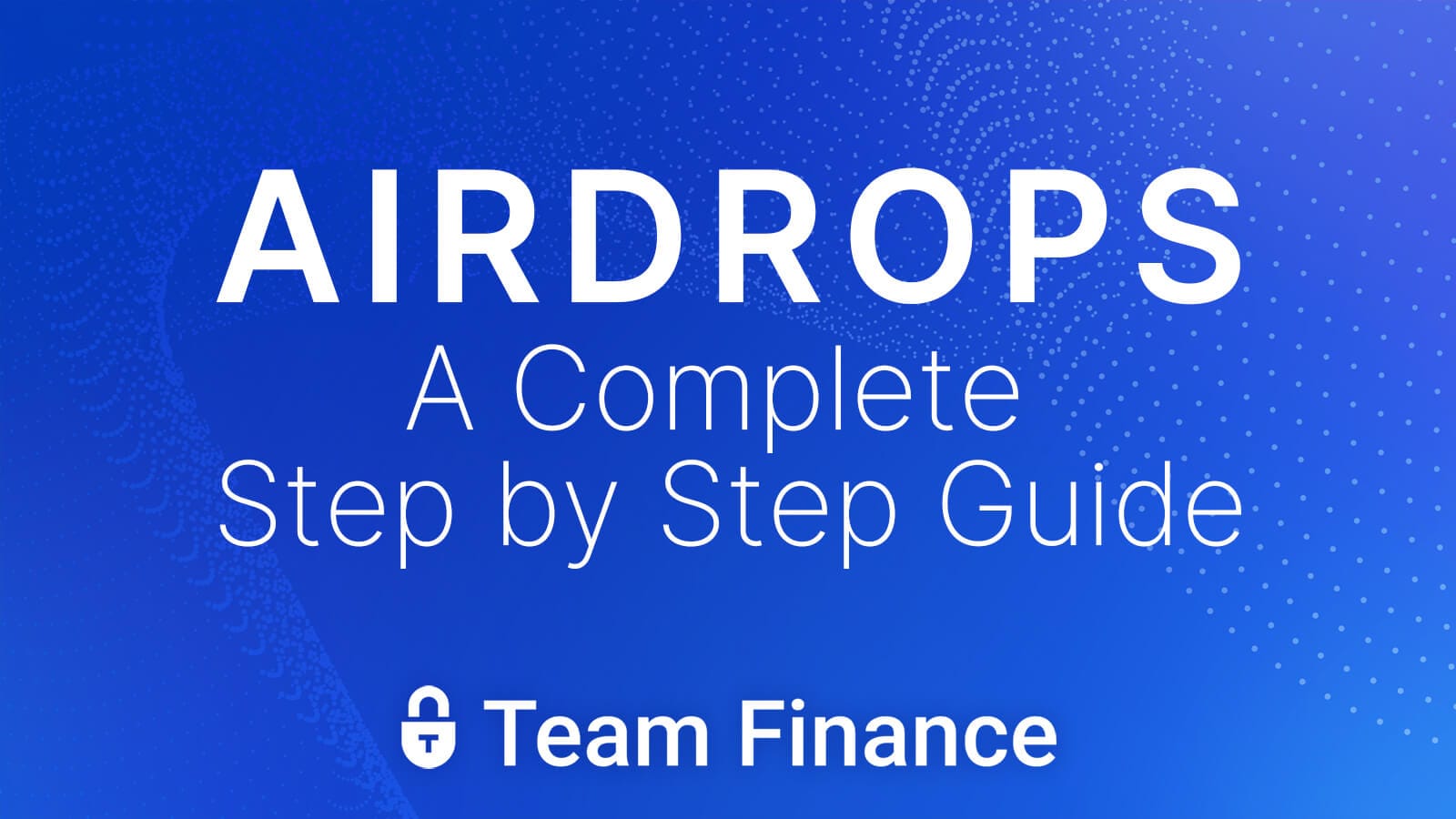How to Create an Effective Airdrop Campaign
From designing your tokenomics, to collecting users, sending your tokens in bulks, and reviewing your airdrop...

Want to know all the steps to designing, preparing, sending, and reviewing your airdrop campaigns?
We put together 10 easy steps for creating token airdrop - aimed at project leaders and developers who want a quick way to gain trust, engagement, and grow your community.
What is an Airdrop?
Simply put: Distributing tokens to multiple recipients wallets.
There are plenty of goals, but it's usually to promote awareness of your web3 project, re-engage an older audience, or increase adoption of your cryptocurrency.
Airdrops are typically used as an effective marketing tool for startups, or as part of a roadmap. Recipients are usually required to complete small / easy tasks to participate - ensuring the group is made of actual humans, rather than bots.
What are the Types of Airdrops?
- Standard Airdrops: These are basic token giveaways where users sign up with their wallet addresses to receive tokens. There's usually a limited supply, so users need to register early to participate. Signups can be anonymous or require X or Telegram usernames/email addresses.
- Bounty Airdrops: Users must complete specific tasks (such as sharing social media posts or joining community channels) to qualify for the token distribution.
- Holder Airdrops: These target existing hodlers. If you hold a minimum amount of a coin, you would get free tokens as part of the campaign.
- Exclusive Airdrops: Llimited to select groups, such as early adopters or members of a list - perhaps key investors, or part of another type of marketing campaign.
Airdrop Campaign Step by Step
Let's get started on our easy 10 step guide...
1. Define Your Airdrop’s Objective
There's no use loading up a wallet with your tokens and sending them into the ether, hoping and wishing for your project to get more engagement or investors. So, what kind of results are you look for?
- Increase awareness of your token or project
- Growing your community on Telegram, Discord, or Twitter
- Rewarding users or early adopters
- Creating liquidity by distributing tokens to future holders
- Encouraging participation in governance, staking, etc.
This first step may feel like it's slowing you down, but without structure and an end-goal, you're going to miss out on the ability to properly structure marketing, distribution, and engagement opportunities.
2. Identify Your Target Audience
Next, decide who will receive your tokens.
Targeting the right audience is important for maximizing the airdrop's impact (marketers could spend days talking about this subject).
Make sure you define who you're targeting:
- Existing token holders: Reward people who already hold.
- New users: Reach new users who meet specific criteria, such as social media engagement or activity.
- Stakers: Distribute tokens to those staking assets.
- Referrals: Encourage users to bring new members to your project.
You can be very open and general in your targeting for your first campaigns - especially if you're just looking for more engagement. But, when trying to re-activate your community, or re-engage old users, you might want to get more specific.
3. Set Clear Eligibility Criteria

Should everyone be able to enter your airdrop campaign for free?
How about asking participants to complete a set of objects to drive more engagement?
Here's a few more ideas for you:
- Holding a minimum amount: For example, require participants to hold a certain amount of your project’s token or a related asset.
- Completing tasks: This could include following your social channels, joining Telegram, or interacting with your dApp.
- Downloads: Perhaps users need to download a resource, or submit their email address on your website/newsletter.
Early on, you may just want to allow anyone to participate (unless they're not legally viable? More on this later).
4. Decide on Token Allocation
There's a lot of reasons to properly set your allocations and distribution model, not just making sure the market doesn't go sideways. But also ensuring the supply, eligibility, and distribution is properly handled:
- Total airdrop pool: Decide on the percentage of your total supply that will be allocated for the airdrop. This is often between 1-5%.
- Per participant: Set how many tokens each eligible participant will receive. You can distribute tokens equally or base the amount on engagement (e.g., more tasks completed = more tokens).
- Vesting schedule: To prevent an immediate sell-off, consider a vesting schedule where a number of tokens are released over time, keeping users engaged longer.
This not only helps you with tokenomics, but also provides value to your team, community, and the airdrop participants. It's a necessary step in the process.
5. Choose the Distribution Method
How are you going to send your tokens in bulk?
Doing it manually is fine for small groups, but you may have thousands of recipients - no one is going to sit up all night and do this one-by-one:
- Manual Distribution: Collect wallet addresses and send tokens manually, which can be time-consuming to say the least.
- Smart Contract Automation: Automate token distribution via smart contracts. Do developers still create smart contracts just for airdrops?
- Multisenders: Automated platforms that bulk send tokens to addresses entered manually, or via CSV upload.
For most cases, I'd recommend you use our token multisender. Which is available on 19+ blockchains, including Sepolia to help you test your airdrop before going live - just to make sure everything is working as intended.
6. Set the Campaign Timeframe
Timing is key - or so they say. You have infinite timing schedules to choose from, but let's stick to some tried and tested ones:
- Sign-up period: Allow users to join the airdrop over a specific period, such as two weeks or a month. Give yourself enough time for the marketing to be effective!
- Distribution date: Decide when tokens will be sent.
- Campaign duration: Do you want to run a singular campaign, or multiple smaller ones over time?
Make sure to communicate these timelines clearly to avoid confusion and build excitement around key dates.
7. Airdrop Marketing Campaigns - Promotion

Create some buzz, hire an effective marketing team, and really treat the airdrop with the care and attention it deserves. They're such an effective marketing tool, it would be a shame if you missed where your audience actually lives:
- Social Media Campaign: Share the airdrop across platforms like Twitter, Telegram, Discord, and Reddit.
- Influencer Marketing: Work with crypto influencers to help promote your airdrop and gain credibility. This is probably the most costly, you'll either be giving away resources, assets, or money.
- Email Campaigns: Do you already have an email list you can leverage? Or maybe tap into a similar project's list?
- Press Releases: Paid or organic, you need to create some form of blog post or PR article. Depending upon your budget and reach, you may be able to get these promoted on sites like CoinTelegraph.
- Communicate the Benefits: Be sure to explain why users should care about your crypto project and how the tokens will benefit them.
Building a solid marketing plan will help create pre-releases buzz, and allow communities to queue this up their calendars, prepare, and help you find new audiences.
8. Launch the Airdrop 🚀
With everything in place, it’s time to launch the campaign. Make sure your distribution system is tested and ready, and provide clear instructions to participants.
- Test the process: Use a testnet or simulation to ensure the airdrop works as intended (we offer Sepolia for free)
- Support channels: Have support ready on social media or messaging platforms to assist with participant questions or issues. Make sure you train them and have some form of ticketing system for tracking issues.
- Transparency: Clearly outline the rules, deadlines, and requirements on your site, socials, and any documentation.
Then simply close your eyes, press the big "Go" button, and blame someone else if it goes wrong.
9. Analyze and Optimize
Don't just track performance at the end of the campaign - check the moment you start marketing or sending tokens. Make sure it's all running properly, and you're getting the results you wanted (remember the goals we set above?).
- Participation numbers: How many people joined?
- Social media growth: Did your community grow? How was engagement on your channels?
- Token activity: Are users holding, trading, or staking your tokens?
- Platform usage: If your goal was to drive traffic to a platform or product, measure interactions and activity.
Review your project at the end. You might be surprised what you missed, what went wrong, and what you could improve upon next time. Also seek feedback from your team and community. A simple poll in Telegram might work best.
10. Prevent Sybil Attacks

Airdrops can be targeted by bots or users with multiple accounts (Sybil attacks) trying to claim extra tokens. We can't offer direct security advice, but be mindful of:
- KYC (Know Your Customer): Require identity verification to prevent abuse, though this may reduce participation.
- Wallet history checks: Distribute tokens only to active wallets or those holding tokens before a specific snapshot.
- Whitelist: Pre-select eligible participants using wallet history or community membership.
Scammers, bots, and exploiters get smarter by the day. You can't plan for every eventuality, but layering your security is a must. Read up, be informed, be safe.
🎁 Bonus: Regulatory Compliance
Depending on your region, you may need to comply with regulations for token distribution / airdrops. In some jurisdictions, tokens may be classified as securities, requiring KYC or other compliance measures. Always check local laws before launching your airdrop to ensure you're on the right side of the law.

